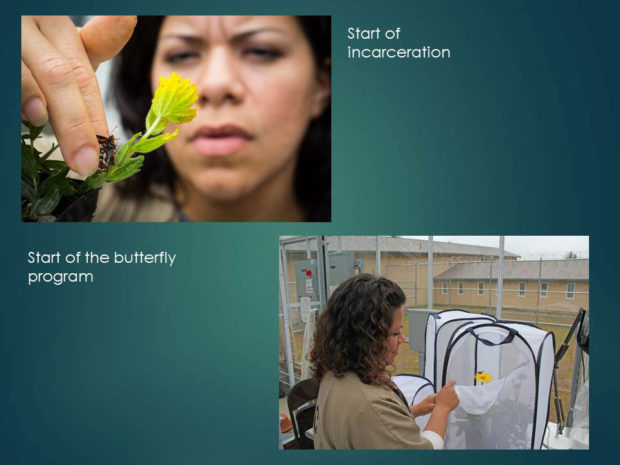
One of Mission Creek’s captively bred Taylor’s checkerspot butterflies basking shortly after release on Joint Base Lewis-McChord prairie. Photo by Seth Dorman.
Another wonderful rearing season is coming to a close at Mission Creek Corrections Center for Women. This year butterfly technicians and staff woke up sleeping caterpillars or larvae in early February. The “sleep” phase of the butterfly’s life cycle is called diapause. Since wake-up, the capable butterfly technicians at Mission Creek have been working hard to provide excellent care at each life stage (i.e., larvae, pupae, adults, eggs), while also collecting extensive environmental and life stage summary data.

Butterfly technicians feed post-diapause larvae for the first time after “wake-up.” Photo by Seth Dorman.

A post-diapause larva feeding captured by the butterfly technicians with a digital microscope, a recent addition to the butterfly greenhouse this season.
Once our 2,800 plus larvae woke from their winter slumber it was off to the races and it was a challenge to make sure all of the growing animals were well fed. After sleeping through the fall and winter, these post-diapause or 5th instar larvae were hungry and eager to store up enough energy to molt one final time before entering their pupal life stage. The larvae are kept in deli containers with 15 per cup and each cup can eat two or three plantain leaves a day! That means a lot of plantain leaves need to be gathered and washed every morning to keep all of our hungry larvae satisfied. This year, pesky deer began grazing on our plantain plants beds during the night, so the butterfly technicians designed a cover made out of bird netting to ward them off.

Butterfly technicians, Michelle Dittamore and Eva Ortiz, release post-diapause larvae in Mima Mound prairies while PBS captures every step on film. Photo by Sadie Gilliom.
In late February, just over 2,500 of our post-diapause larvae were released into the wild at two reintroduction sites located on South Sound prairies. This year, two of the butterfly technicians were able to travel from the prison to the field to help with the release for the first time in the butterfly program’s history! Also participating in the release was Carolina Landa, a former butterfly technician and current SPP Advisor and student at The Evergreen State College. A reporter and camera person from the PBS NewsHour and several other media representatives filmed the release.

Previous butterfly technician, Carolina Landa, releases pre-diapause larvae into the wild. Photo by Sadie Gilliom.
Mission Creek retained 350 larvae for breeding. We welcomed our pupa on March 12th and first adult butterfly on April 15th. Once the first few lineages of adults emerged from their chrysalis or pupal stage, the butterfly technicians began pairing lineages and placing them in breeding tents. Since the adult butterflies are finicky about where they like to breed, technicians typically move them around the greenhouse until the butterflies seem satisfied by sunlight and temperature conditions.
During the height of the breeding season, the Oregon Zoo’s Head Butterfly Keeper, Julia Low made a visit to Mission Creek to offer suggestions to the butterfly technicians on maximizing breeding. She admitted to taking a few notes of her own, learning from the technicians at Mission Creek. After a pair of butterflies has bred or copulated, they are placed in a deli container until the female is ready to be placed into an oviposition or egg-laying chamber. The chamber is filled with host plants for the female to lay her eggs on and prairie nectaring flowers to help stimulate egg laying.

Eva Ortiz juggles multiple breeding tents while trying to find optimal breeding conditions. Photo by Seth Dorman.

Butterfly copulation or breeding event. Photo by Seth Dorman.

Gravid adult female placed in oviposition chamber for egg laying. Photo by Kelli Bush.

Butterfly technicians Cynthia Fetterly and Jessica Stevens discuss egg collection strategies. Photo by Kelli Bush.
This season two new butterfly technicians, Cynthia Fetterly and Jessica Stevens, joined the rearing team and proved to be invaluable throughout the season. In addition to learning all of our husbandry protocols outlined by the Oregon Zoo and getting experience with all of the butterfly’s life stages throughout the season, they also took upon themselves to work extensively with monitoring the egg-laying females and caring for each of the egg clusters laid by our captive and wild females. Although we came just short of our egg targets this year, we were able to meet our target with some help from the Oregon Zoo and are projected to have just over 3,000 larvae for release and breeding next season.

Julia Low with the Oregon Zoo chatting butterfly husbandry with the technicians at Mission Creek. Photo by Seth Dorman.

Mission Creek butterflies being released by Mary Linders. Photo by Seth Dorman.
After breeding concluded, 125 of our captive adults were released on one of our reintroduction sites on Joint Base Lewis-McChord. The adults were released by Biologist Mary Linders of Washington Department of Fish and Wildlife and SPP Program Coordinator Seth Dorman.
The butterfly technicians are currently occupying our 3,000 larvae that have hatched successfully and will continue feeding until they have molted five times and return to diapause through the fall and winter.

Butterfly technicians pose in front of educational poster set up for Girl Scouts Behind Bars visiting the butterfly greenhouse. Photo by Seth Dorman.































































